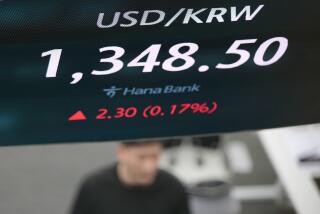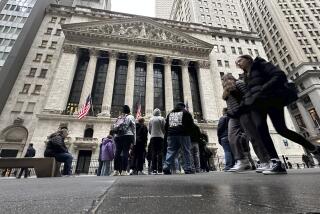S&P 500 closes above 2,000; investors may get a psychological boost

The Standard & Poor’s 500 stock index, a widely watched measure of a broad array of stocks, closed above the 2,000 level for the first time as investors pushed aside worries over global unrest to focus on the improving domestic economy.
The latest roar from a five-year bull market took the large-company S&P index to a hair above the psychological threshold, at 2,000.02 — a level that could send an upbeat signal to investors. It first crossed the level in Monday morning trading but settled below it at the close.
------------
FOR THE RECORD:
S&P 500 record: An article in the Aug. 27 Business section on the Standard & Poor’s 500 stock index closing above 2,000 for the first time identified Bruce Simon as the chief investment strategist for City National Asset Management. Simon is the chief investment officer for City National Rochdale.
------------
Round-number levels such as 2,000 for the S&P are considered by many to be positive indicators for the market, though there is little scientific evidence of what they signify, said Bruce Simon, chief investment strategist for City National Asset Management in Los Angeles.
From the point of view of chart-driven analysts, such numbers can become barriers preventing stock prices from rising higher or, after a breakthrough occurs, from falling, Simon said.
“Psychologically, people view these big numbers as a ceiling you have to work up to,” he said. “Once you break through conclusively they start viewing [the number] as a floor instead of a ceiling.
“From a technical point of view, if we close above 2,000 for a couple of days, it should provide a positive boost for market psychology and momentum.”
Stocks tumbled earlier this summer on worries over conflicts in the Ukraine and Middle East; the S&P 500 sank 1.5% in July, closing the month at 1,930.67.
But the S&P is up 3.6% this month, with narrower but also widely watched indexes following suit. The Dow Jones industrial average of 30 blue-chip stocks has gained 3.1% and the Nasdaq composite index, home to many technology companies, has risen 4.6% so far in August.
The S&P 500’s latest record takes the index to more than triple its low point of 666 on March 9, 2009, when the bull market began.
Recent economic news has given fresh reasons for stock market bulls to stay confident. Central bankers from around the world, gathered for an annual powwow in Jackson Hole, Wyo., last weekend said they would concentrate on stimulating wages and employment — reassuring the markets that interest rates would remain near record lows.
“I think people are focusing on the economic backdrop, weeding out the geopolitical concerns that crop up every day,” Simon said. In addition to a steady U.S. economy and low inflation, he said, “most other assets look pretty well valued.”
Indeed, there are few alternatives to the stock market for average investors seeking to see their savings grow.
Banks are so awash in cash that most are paying nearly nothing for deposits. A survey by Informa Research shows the national average yield on a five-year certificate of deposit is just over 1%. And the average for money-market funds last week was just 0.02%.
Investors buying a 10-year Treasury bond Tuesday would be guaranteed an annual return of just 2.4%. That would mean an effective loss if inflation returns to its 100-year average of 3.2%, and a bigger loss should it revert to its average of 5.5% in the 1980s or 7% in the 1970s.
Consumers’ improving outlook on the economy may be buoying stock prices. The Conference Board, a private research group, said Tuesday that its consumer confidence index had risen from a revised 90.3 in July to 92.4 this month. The consensus of economists had been for a decline to 88.8.
In a positive sign for manufacturing, demand for U.S. commercial airplanes pushed orders for durable goods — big-ticket items meant to last at least three years — up 22.6% to $300 billion in July from the previous month, the Commerce Department said Tuesday.
The increase, attributed largely to higher sales at Boeing Co., was the largest percentage monthly increase since the government began tracking such sales in 1992. The consensus of economists had been for an increase of just 5.5%, according to data provider FactSet.
Corporate acquisitions also have helped propel the market. Shares of Burger King Worldwide Inc. gained more than 14% this week on news that it plans to merge with Canadian coffee-and-doughnut chain Tim Hortons Inc., enabling it to set the headquarters for the new holding company in Canada, where the corporate tax burden is lower.
“Investors are looking for higher octane. And they have convinced themselves that it’s OK to go a little out on the risk curve by investing in stocks,” said Sam Stovall, U.S. equity strategist at S&P Capital IQ.
S&P 500 companies that managed to raise their earnings and dividends through the difficulties of the last 10 years are good bets, Stovall said.
These stocks, many with such household names as Walt Disney, General Electric, Chevron and CVS Caremark, are now priced at a discount to lower-quality stocks based on expected 2014 earnings, he said, providing above-average dividend payments with the potential for capital appreciation.
The rise of the S&P 500 itself illustrates the value of stock investing over time, Stovall said. The index topped 100 for the first time in 1968, crossed 1,000 in 1998, and took just 94 days to climb from 1,900 to 2,000.
“I think investors like to look at century and millennium marks mainly because it’s a reminder that stock prices over the long term tend to go up,” Stovall said.
Twitter: @ScottReckard







